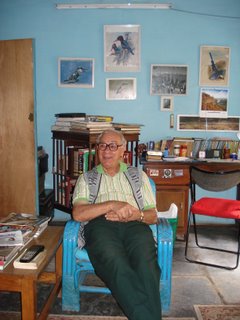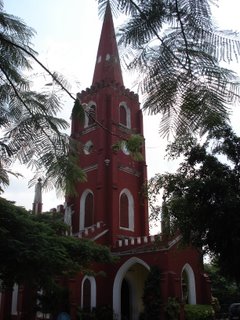Those missionaries, in contrast, were totally adrift, with no sense of what they might expect and few, if any support structures to turn to. Strange country, strange people, strange food and a whole battery of unpleasant diseases.
 En route to Kanyakumari, we passed many wayside cemeteries, - and the crosses there reminded me of the missionaries who literally gave their lives for the people of India, just because they loved God and felt called by him to take his love into new places.
En route to Kanyakumari, we passed many wayside cemeteries, - and the crosses there reminded me of the missionaries who literally gave their lives for the people of India, just because they loved God and felt called by him to take his love into new places.In their turn, they deserve to be remembered with love – and indeed they are.
They are the unofficial saints of CSI, spoken of with affection undulled by the years. Their faith challenges me. To journey so far, and risk so much for the love of God and his people - in comparison, I know I haven't even made the starting blocks.
Today, their obvious legacy is the churches, schools and hospitals that so often bear their names, - Sawday Memorial Church, Hudson Memorial, Platt Memorial - and their sepia photographs remain on the walls of many presbyteries and ashrams. Better still, their emphasis on love in action has clearly continued to shape C.S.I. so that the social work that the church is involved in makes all the difference in the world to so many.
The Karnataka diocese is rightly proud of its social action programme and was anxious that we should experience it at first hand, so our first 10 days were projects, projects all the way. If I’m honest, while the first few in each category made a huge impact, this diminished somewhat as we were exposed to more and more of the same. For me, our visit culminated in a marathon day spent trailing the Bishop as he dedicated a new church, launched the centenary booklet at another, opened a project for school drop-outs, and a community dining hall, and presented the certificates to graduates of another programme for disaffected young people. By the end of the day, most of us in the semi-offical party wore glazed expressions, and were beginning to panic at the thought of yet another garland (no ceremony in India is complete without flowery speeches in all directions, and numerous presentations to guests of honourThe wor itself was, and is, all tremendous stuff though and I mentioned to the Bishop’s wife my admiration for the church’s involvement in social action.
Her response was typically robust
“If the church isn’t involved in this sort of work, then the church is meaningless”
Ouch. I suspect she’s right, but it can be hard to see where to start in a context as comfortable as ours here.
Perhaps that’s one reason why some missionaries, even today, elect to spend their whole lives in India. If you can fall in love as thoroughly as I did in just one month, its easy to imagine that working there for a longer period might irrevocably spoil “home” for you. I met one such long-term missionary, Brother John, on my first Sunday in Bangalore.
 Conversation with him was fascinating for, now in his 80s, he has been in India for most of his adult life, living through the “quit India” campaign of the 40s and the terrible violence surrounding partition. He spoke of "Gandhi-ji" as a friend, and had known E. Stanley Jones (who wrote the wonderful Christ of the Indian Road) well too. As he talked to us, history lived and his whole being shone with love for the country and its people. Before we left, he took us outside his one-roomed home, in the compound of St John’s Church, and showed us the garden he had made. The trees which towered above us were all of his planting.
Conversation with him was fascinating for, now in his 80s, he has been in India for most of his adult life, living through the “quit India” campaign of the 40s and the terrible violence surrounding partition. He spoke of "Gandhi-ji" as a friend, and had known E. Stanley Jones (who wrote the wonderful Christ of the Indian Road) well too. As he talked to us, history lived and his whole being shone with love for the country and its people. Before we left, he took us outside his one-roomed home, in the compound of St John’s Church, and showed us the garden he had made. The trees which towered above us were all of his planting.This had been home for him for 40 years, and that’s a long time even in arboreal terms…

He’s still at work planting seeds, as he was due to run a mission in one of the city’s senior schools in the two weeks after we met…
I’m willing to bet that some of those seeds will grow too,- like those planted by his predecessors in the mission field.
No comments:
Post a Comment